What is the secret transformative power of continuous improvement tools in the realms of Lean management and manufacturing? By selecting the optimal tools, businesses can significantly boost productivity, minimize errors, and increase profitability.
These tools, integral to achieving strategic goals, have proven their worth across various sectors. A study representing data from over 300 companies revealed a direct positive correlation between continuous improvement practices and enhanced customer satisfaction. (ResearchGate)
But how do you know which tools and methods suit your organization or specific organizational challenges? This guide aims to help you choose the most effective options to refine your Lean processes, enhance quality control, and elevate operational efficiency.
What Are Continuous Improvement Tools?
Continuous improvement tools are essential for a smooth continuous improvement process. These are Lean techniques that provide different approaches for implementing improvement changes. They help organizations reduce risk and boost work efficiency by identifying roadblocks and inefficiency in processes.
When used appropriately, continuous improvement tools have only a positive impact on a company’s performance. First, they outline changes to be made, and second, they create a culture of continuous learning and drive ongoing growth.
What Are the Benefits of Using Continuous Improvement Tools?
Continuous improvement tools play a vital role in enabling companies across various industries to enhance their operations, product quality, and customer satisfaction.
- Enhanced Efficiency and Productivity: Continuous improvement tools help in identifying bottlenecks and inefficiencies within processes.
- Improved Quality: These tools often involve systematic methods for problem-solving and quality control, such as Six Sigma and Total Quality Management (TQM). By focusing on quality at every stage of production or service delivery, companies can minimize defects and errors.
- Increased Customer Satisfaction: Continuous improvement is customer-focused, aiming to enhance the customer experience by proactively addressing issues and adapting to changing needs.
- Fostering Innovation: Continuous improvement's iterative nature encourages a culture of creativity and innovation, as it involves constantly questioning current practices and seeking better solutions.
12 Continuous Improvement Tools and Methods
Your organization has access to numerous strategies to drive its improvement initiatives. Let’s delve into 12 specific methods and tools for continuous improvement.
1. PDCA (Plan, Do, Check, Act)
PDCA cycle is an iterative process that continually improves products, people, and services. It became an integral part of what is known today as Lean management. The Plan-Do-Check-Act model includes solutions testing, analyzing results, and improving the process.
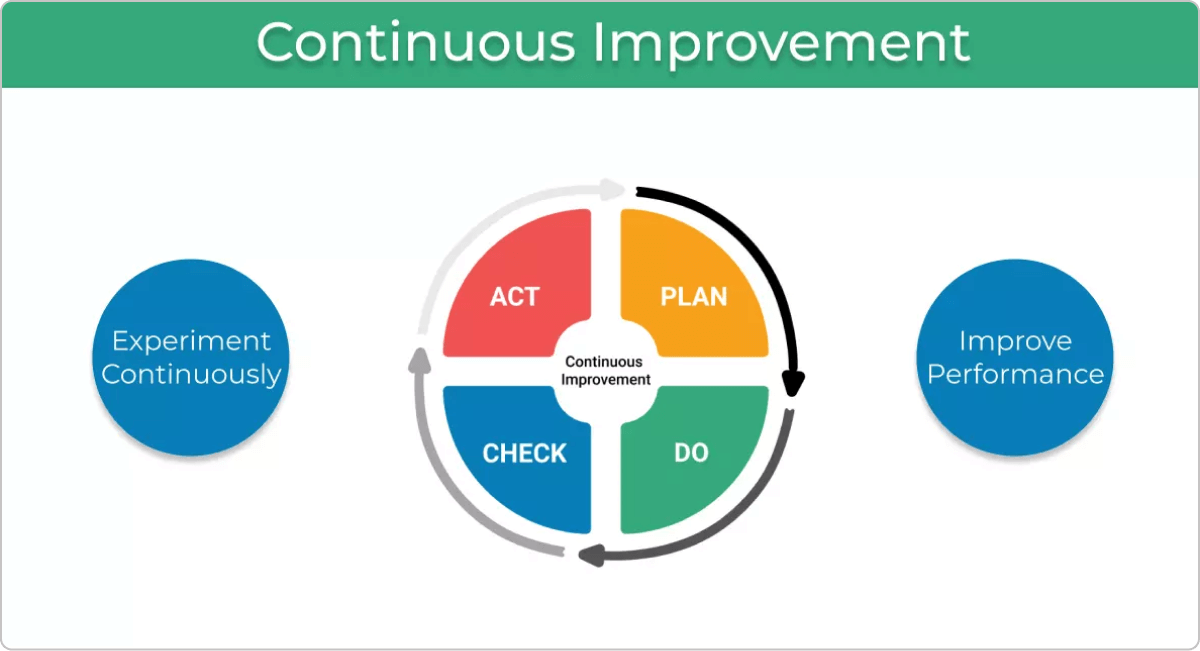
For example, imagine you have plenty of customer complaints about the slow response rate of your support team. Then you must improve how your team works to keep customers satisfied. That is the point where PDCA comes into play.
Let’s take a closer look at the four stages of the PDCA process.
- Plan: This stage involves identifying the problem or opportunity for improvement, setting goals, and developing a plan to achieve those goals.
- Do: In this stage, the plan is put into action. The process is executed, and data is collected.
- Check: In this stage, data is analyzed to determine if the process works as intended. The results are compared to the goals set in the planning stage.
- Act: Based on the analysis of the data, improvements are made to the process. The changes are implemented, and the cycle begins again with the planning stage.
2. Gemba Walk
"Gemba" comes from Japanese, meaning "the real place." In Lean management, "Gemba" is the most important place for a team as it is the place where the real work happens. Taiichi Ohno, widely regarded as the father of Just-in-time production, is credited with originating the Gemba walk, a key concept in Lean manufacturing.
Ohno's development of this concept provides executives with a genuine chance to break away from their daily routines, gain firsthand exposure to the actual work environment, and foster relationships with workers rooted in trust and mutual understanding.
There are three essential elements of this Lean manufacturing tool:
- Go and see. At its core, the Gemba walk offers an opportunity for managers and leaders on every level to take regular walks around the shop floor and to be involved in finding wasteful activities.
- Ask why. A Gemba walk's main objective is to explore the value stream in detail and locate its problematic parts through active communication. An effective leader would always prioritize listening over speaking. Here is why you may use different techniques, such as the 5 whys, to identify problematic parts of the process.
- Respect people. Remember that a Gemba walk is not a "boss walk." Pointing fingers and blaming people is exactly what you shouldn’t do. You are not there to judge and review results. Your presence is meant to foster collaboration within the team and collectively identify and address issues. Try to focus on finding the weak spots of the process rather than on the people.
3. Kanban
While Kanban is not a continuous improvement tool, it is one of the best methods that support the process of continuous improvement through its set of principles and practices.
Kanban is a widely used method for incremental, evolutionary processes and systems change. It's based on a set of six core principles that provide a framework for managing change and delivering services. Adhering to these principles, teams can enhance their workflow efficiency, increase delivery speed, and continuously improve.
How an Engineering Team Doubled Its Output with the Help of Kanban for CI?
By instituting guidelines to prioritize tasks according to urgency and adopting kanban boards, the engineering team at Aerosud, a worldwide aircraft parts manufacturer, successfully visualized and resolved obstacles within their workflow. The implementation of kanban principles, including work-in-progress limits, enabled the IT group to double their output swiftly in a matter of days.
In their quest for greater operational agility and efficiency, the teams leveraged kanban feedback loops as a means to facilitate the exchange of feedback, seamlessly integrating continuous improvement initiatives into their delivery processes.
In addition to adopting the kanban principles and practices, the engineering team at Aerosud also started to make use of the 5 Whys continuous improvement method to find the root cause of problems. (Source: Aerosud Case Study).
4. 5 Why’s
The 5 Whys method, an indispensable problem-solving approach within the Toyota Production System, emerged from the inventive mind of Sakichi Toyoda, a visionary Japanese inventor and industrialist. Its integration into the principles of Lean philosophy has solidified its significance.
The 5 Whys method allows uncovering the root cause of a problem by simply asking "Why" five times. This interrogative technique is one of the most effective tools for root cause analysis in Lean management.
One key factor for the technique's successful implementation is making an informed decision. This means the decision-making process should be based on an insightful understanding of what is happening on the work floor.
When applying the 5 Whys technique, you want to find the problem's true cause and then fix it. The 5 Whys questions may even reveal that the source of the problem is quite unexpected.
How to Apply 5 Whys in Practice?
Problem: We couldn’t send the newsletter about our latest product update on time.
The 5 Questions (Whys) to Ask:
- Why didn’t we send the newsletter on time? Updates were not implemented until the deadline.
- Why were the updates not implemented on time? Because the developers were still working on the new features.
- Why were the developers still working on the new features? One of the new developers didn’t know the procedures.
- Why was the new developer unfamiliar with all procedures? He was not trained properly.
- Why was he not trained properly? Because the CTO believes that new employees don’t need thorough training and they should learn while working.
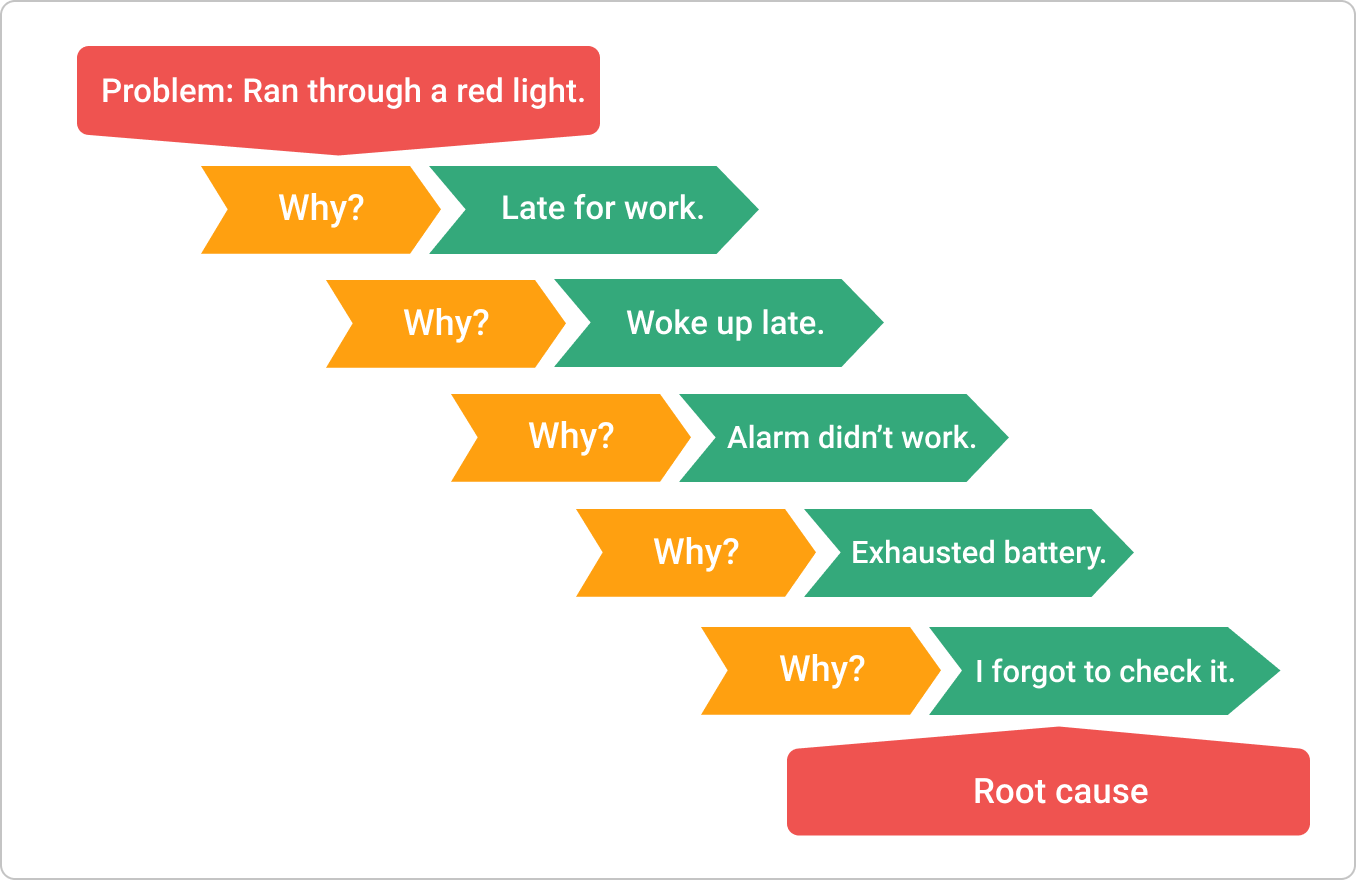
You can notice that the root cause of the initial problem turned out to be something completely different from most expectations. Therefore, the 5 Whys analysis aims to inspect a certain problem in depth until it shows you the real cause.
5. Root Cause Analysis
Root cause analysis (RCA) is a systematic process that aims to identify the underlying causes of problems and establish a methodical approach to address them. The fundamental principle behind root cause analysis is the proactive management philosophy of preventing issues before they arise and impact the entire organization's operations.
Root cause analysis is one of the most crucial problem-solving elements in quality management. It is also an important part of Six Sigma methodology, as it is a key component of the analysis phase of the DMAIC framework.
Six major tools of root cause analysis are used to identify the root causes of a problem.
- Pareto Chart
- The 5 Whys
- Scatter Plot Diagram
- Fishbone Diagram
- Failure Mode and Effects Analysis (FMEA)
- Fault Tree Analysis
Here are the steps to perform root cause analysis.
- Define the problem
- Collect data about the problem
- Determine potential cause factors
- Determine the root cause of the problem
- Prioritize the cause
- Find solutions, gather recommendations, and make the necessary implementation.
6. 3M’s – Muri, Mura, Muda
Eliminating wasteful activities is one of the most important foundations for building a thriving company. This concept is an integral part of Lean thinking and Lean management, and it helps you increase profitability.
The concept of waste elimination finds its roots in the Toyota Production System, pioneered by Taiichi Ohno, a revered figure and pioneer in Lean manufacturing, who dedicated his career to crafting a robust and efficient workflow.
During his journey, Ohno described three major roadblocks that can influence a company’s work processes negatively: Muda (wasteful activities), Muri (overburden), and Mura (unevenness). Thus, the 3M’s of Lean are Muri, Mura, and Muda.
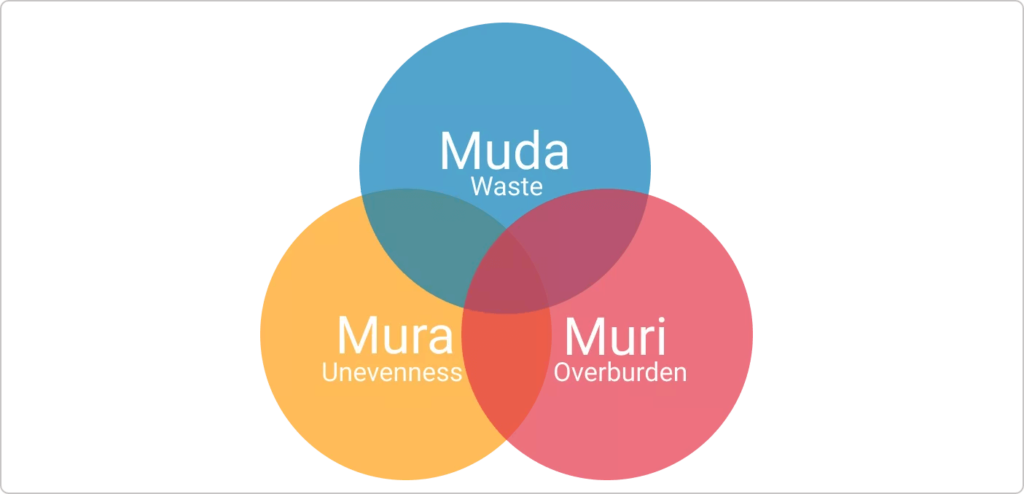
Muda (wasteful activities): Waste in Lean is any activity that consumes resources but brings no value to the end customer. Not all wasteful activities can be eliminated from your work process. Some of them are a necessity. The Lean theory describes 7 major areas where you can identify Muda activities, more popular as the seven wastes of Lean - Transportation, Inventory, Motion, Waiting, Overproduction, Over-processing, and Defects.
Muri (overburden): Muri is a key concept in Lean management. You create Muri whenever you put your team under stress by demanding unreasonable or unnecessary work that exceeds their capacity. Muri can drastically decrease your team’s productivity and efficiency. You should try to balance at the optimal capacity – a level at which all parts of the system can deliver results without the need for extra work.
Mura (unevenness): Mura is the waste of unevenness or inconsistency. Mura occurs when there is an imbalance in resource allocation, resulting in either overburdening certain resources while others wait or a cyclical pattern of overburdening and underutilizing the same resources. There are two major ways to identify unevenness in your process by applying Lean - visualizing your workflow on a kanban board and measuring your process stability with a cumulative flow diagram (CFD).
7. Kaizen
Kaizen is an effective approach that promotes continuous improvement, emphasizing the value of small, incremental changes. The approach is based on cooperation and commitment, in contrast to radical or top-down transformations that may disrupt operations. Kaizen is integral to Lean Manufacturing and the Toyota Way, originally designed to minimize defects, eliminate waste, enhance productivity, encourage worker responsibility and accountability, and foster innovation in the manufacturing industry.
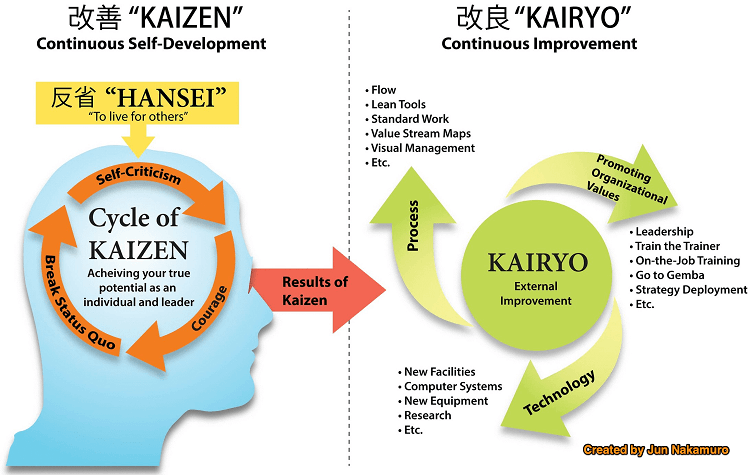
Image credit: Jun Nakamuro
Kaizen is primarily an internal journey unfolding within one's own mind. The goal is to unlock untapped potential, break the status quo, and achieve improvement. A more precise way to define Kaizen would be "continuous self-development."
Embedded within the Kaizen philosophy is the core principle of Respect for People. The Kaizen approach involves identifying areas for improvement, finding effective solutions, and implementing them. This iterative process ensures that any unresolved issues are revisited in subsequent cycles.
To facilitate continuous improvement, a structured seven-step cycle can be employed, providing a structured methodology for executing this process.
The process involves the following steps:
- Foster employee involvement
- Identify problems
- Develop a strategic solution
- Pilot the solution
- Evaluate the outcomes
- In the event of positive outcomes, it is recommended to implement the solution organization-wide.
- It is advisable to continuously repeat these seven steps to test new solutions as needed or address new problem lists.
8. Value Stream Mapping
Value stream mapping (VSM) is an essential Lean management tool used to visualize, analyze and improve all the steps in a product or service delivery process. VSM represents the entire flow of goods, materials, or information from the supplier to the customer. The technique is also part of the Six Sigma and Lean Six Sigma methodologies for process improvement.
VSM entails the creation of a meticulous map that encompasses all the significant steps involved in delivering value throughout the entire workflow. By doing this, the approach facilitates the identification of waste, inefficiencies, and areas primed for improvement.
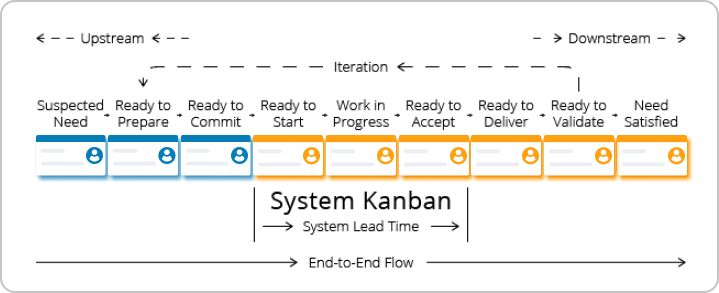
Mapping an entire end-to-end value delivery flow
The primary goal of creating a value stream map is to indicate opportunities for process enhancement by visualizing both its value-adding and non-value-adding steps.
To get started, you need to map every vital step of your workflow, activities, or resources involved and evaluate how that brings value to your customer. This comprehensive analysis would enable a thorough examination of your process and provide you with precise insights into the areas that need to improve.
Here are the steps to create a value stream mapping with Kanban:
- Create a kanban board
- Define VSM purpose and expectations
- Visualize the key stages of your workflow
- Perform value stream map analysis
9. A3
The A3 report, aLean management tool originating from the Toyota Production System (TPS), derives its name from the European A3 paper size corresponding to 11 inches by 17 inches or 29.7cm x 42cm. The A3 report is a single-page document that reflects the results of the entire process. Usually, it contains seven steps, but with potential variations.
Implementing an A3 problem-solving tool is a bright example of how problems should be treated to be eliminated efficiently. By following simple steps and principles, this model guides problem-solving through structured organization, collaborative teamwork, and proactive communication.
The A3 methodology embodies the principles of Lean thinking, where the problem owner should tackle each of the model's different steps until a suitable solution is reached. The owner needs to communicate actively with his colleagues and the mentor of the project.
These are the different steps that comprise the A3 process:
- Background/clarify the problem
- Current situation
- Set targets/goals
- Root cause analysis
- Countermeasures
- Implementation
- Effect confirmation/follow-up
10. Poka Yoke
The term Poka-Yoke (poh-kah yoh-keh) was coined in Japan during the 1960s by Shigeo Shingo, an industrial engineer at Toyota. Shingo also developed and formalized the concept of Zero Quality Control, which combines Poka-Yoke techniques for defect correction and source inspection for defect prevention.
Poka-Yoke guarantees that the necessary conditions are in place prior to executing each process step, effectively averting defects from arising initially. Where this is not possible, Poka-Yoke performs a detective function, eliminating defects in the process as early as possible.
Poka-Yoke serves as a mechanism within Lean manufacturing processes to prevent errors and mistakes. Its primary objective is to eliminate product defects by preventing, correcting, or drawing attention to human errors as they occur.
The implementation of Poka-Yoke holds immense value as it ensures that people and processes operate flawlessly from the very beginning, making mistakes virtually impossible. These techniques can significantly improve the quality and reliability of products and processes by effectively eliminating defects.
11. Bottleneck Analysis
A process bottleneck occurs when a particular stage of work receives more requests than it can handle at its maximum capacity for processing. That causes an interruption to the flow of work and leads to delays across the production process. Process bottlenecks are often the reason why your projects are costly and slow.
Even if the affected work stage operates at its peak efficiency, it still cannot process all the work items in a timely manner to transition them smoothly to the next stages. The workflow bottleneck can be a computer, a person, a department, or an entire work stage.
Simple yet effective analysis tools in Lean Management and Kanban can help you prevent work congestion and identify existing bottlenecks. If you see that your workflow is unpredictable and operates in bursts, you have a bottleneck somewhere instead of a smooth flow.
How to Identify a Bottleneck in 3 Steps?
- Visualize. Keeping track of your work on a central workflow management board makes it very easy to see where work piles up, which is a strong sign of a problem, most likely a bottleneck.
- Map Queues and Activities. When you separate queues and activities and map them on the visual board, you can see how long work is waiting in a queue prior to a certain activity. If this queue grows significantly faster than work is processed (stays in an activity stage), you have found your bottleneck.
- Measure Cycle Time per Stage. Measuring cycle time of how long work items spend at every process stage allows you to further analyze the problems. In Businessmap, for instance, you can use the data in a visually appealing cycle time heatmap. Just glancing at the diagram reveals the stages where work spends the most time. If these workflow stages are queues, too, those are probably your bottlenecks.
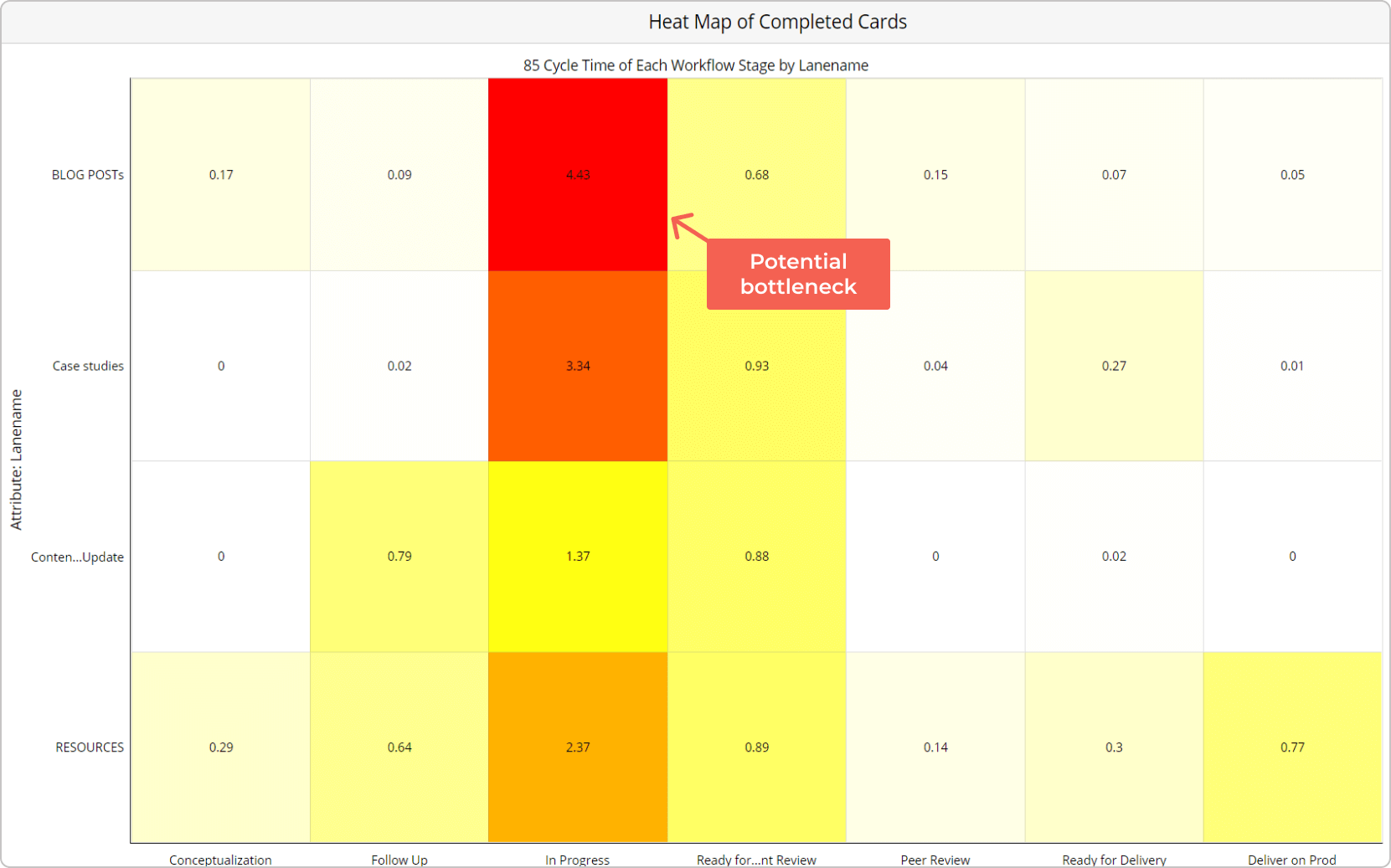
The fundamental element for maintaining a robust and efficient workflow is to minimize interruptions to the process as much as possible. The work has to stream through it freely, powered by the force of a pull system.
How to Handle a Bottleneck in 5 Steps?
- Never leave it idle. Because of the ripple effect on the rest of the flow, the bottleneck process should always be loaded at full capacity.
- Reduce the strain on the bottleneck. Make sure that work arrives at it in its very best form.
- Manage WIP limits. If the work-in-progress limits in kanban are quite liberal in the bottleneck and there is a lot of context switching, consider lowering the WIP limit. If it doesn’t have a WIP limit, consider setting one.
- Process work in batches. If you organized similar work items in batches, some operations would take less time. The rule of thumb is that a smaller batch is always better, but we sometimes have to make compromises in the real world.
- Add more people and resources. If you can, increase the capacity of the bottleneck to speed up the whole process.
Following the Lean management concept of continuous improvement, bottleneck analysis should also be an ongoing process.
12. 5S Method
The 5S is a Lean method and one of the foundations of continuous improvement (Kaizen). It consists of 5 consecutive steps that enable teams to organize their workplace for maximum process efficiency. 5S is a great way to minimize the 7 wastes of Lean (also known as Muda).
The 5S approach encompasses the following elements:
- Sort (Seiri). Separate required tools, materials, and instructions from those that are not needed. Remove everything that is not necessary from the work area.
- Set in order (Seiton). Sort and organize all tools, equipment, files, data, material, and resources for quick, easy location, and use. Label all storage locations, tools, and equipment.
- Shine (Seiso). Set standards for cleanliness. Clean and remove all trash, grease, and dirt. Cleanliness provides a safe workplace and makes potential problems noticeable (e.g., equipment leaks, loose parts, loose paperwork, or materials).
- Standardize (Seiketsu). Engage the workforce to systematically perform steps 1, 2, and 3 above daily to maintain the workplace in perfect condition as a standard process. Establish schedules and set expectations for adherence.
- Sustain (Shitsuke). Build organizational commitment so that 5S becomes one of your organizational values so that everyone can turn it into a habit.
Implementing 5S is among the first steps you should take when introducing Lean practices. Moreover, 5S is a great way to maintain formidable discipline in your team and increase the built-in quality of their work.
How to Get Started with Continuous Improvement?
It is well known that the culture of continuous improvement has many layers of benefits. It has become such a hot topic in recent decades that so many businesses have turned to this ongoing process of making incremental improvements to systems, processes, products, or services.
Adopting this model of managing work may be overwhelming at first, as few sources of information provide an actionable plan for implementing it in business life.
To help with that and reduce the level of stress, we have prepared a list of 5 ways to start with continuous improvement. This list includes:
- Visualize workflows using a visual board.
- Adopt continuous improvement meetings such as daily stand-up.
- Adopting a culture of shared leadership.
- Optimize communication within your team.
- Adopt workflow management tools offering powerful automation capabilities.
- Make continuous improvement part of your culture.
Stay informed with our dedicated article about how to get started with continuous improvement and be fully prepared for this organizational transition.
In Summary
There are many continuous improvement tools that you can implement in your organization to support a smooth and ongoing process of continuous improvement.
All of the continuous improvement tools share one common objective - analyzing what can be done better compared to the past. You can use these tools to:
- Minimize the waste in your process
- Create a suitable environment for your team to improve
- Find the root cause of existing and potential problems
- Sort the necessary from unnecessary tools for your team
- Standardize your work process

Mila Chervenkova
Marketing Expert | Agile, Kanban & OKR Practitioner
Mila is a seasoned marketing professional with a rich background in product marketing, content creation, and website optimization. Years of Practicing Kanban, Agile, and OKR practices have made her an expert in creating powerful productivity habits.



